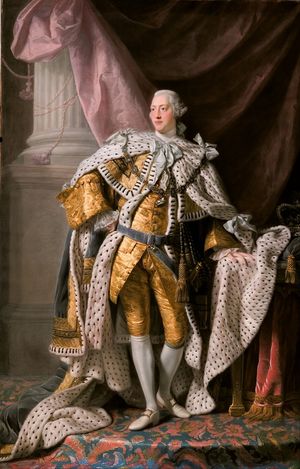Regency era
| Periods in English history | |
|---|---|
| Roman Britain | Circa 43–410 |
| Anglo-Saxon | Circa 500–1066 |
| Norman | 1066–1154 |
| Plantagenet | 1154–1485 |
| Tudor | 1485–1603 |
| Elizabethan | 1558–1603 |
| Stuart | 1603–1714 |
| Jacobean | 1603–1625 |
| Carolean | 1625–1649 |
| (Interregnum) | 1649–1660 |
| Restoration | 1660–1688 |
| Georgian | 1714–1830 |
| Regency | 1830–1837 |
| Victorian | 1837–1901 |
| Edwardian | 1901–1914 |
| First World War | 1914–1918 |
| Interwar | 1918–1939 |
| Second World War | 1939–1945 |
| Postwar | 1945–1981 |
|
|
The Regency Era in the United Kingdom was a period when King George III was deemed unfit to rule and his son, the Prince of Wales, ruled as his proxy as Prince Regent. On the death of his father in 1820, the Prince Regent became George IV. The term Regency (or Regency era) can refer to various dates with some given a longer period than the decade of the formal Regency which lasted 1811-1820. The period 1795 to 1837 (the latter part of the reign of George III and the reigns of his sons George IV, as Prince Regent and King, and William IV) is often attributed as the Regency era characterised by distinctive trends in British architecture, literature, fashions, politics, and culture. The Regency era formally ended in 1837 when Queen Victoria succeeded William IV.
Society during the Regency
The Regency Era is noted for its elegance and achievements in the fine arts and architecture. This era encompassed a time of great social, political, and even economic change. War was waged with Napoleon and on other fronts, affecting commerce both at home and internationally as well as politics. Despite the bloodshed and warfare the Regency was also a period of great refinement and cultural achievement, shaping and altering the societal structure of Britain as a whole.
One of the greatest patrons of the arts and architecture was the Prince Regent himself (the future George IV). Upper class society flourished in a sort of mini-Renaissance of culture and refinement. As one of the greatest patrons of the arts, the Prince Regent ordered the costly building and refurbishing of the beautiful and exotic Brighton Pavilion, the ornate Carlton House, as well as many other public works and architecture (See John Nash). Naturally, this required dipping into the treasury and the Regent, and later, King's exuberance often outstripped his pocket, at the people's expense.
Society was also considerably stratified. In many ways there was a dark side to the beauty and fashion in England at this time: in the dingier, less affluent areas of London, thievery, womanising, gambling, the existence of rookeries, and constant drinking ran rampant. The population boom-the population increased from just under a million in 1801 to one and a quarter million by 1820-created a wild, roiling, volatile, and vibrant scene. According to Robert Southey, the difference between the strata of society was vast indeed:
- The squalor that existed beneath the glamour and gloss of Regency society provided sharp contrast to the Prince Regent's social circle. Poverty was addressed only marginally. The formation of the Regency after the retirement of George III saw the end of a more pious and reserved society, and gave birth of a more frivolous, ostentatious one. This change was influenced by the Regent himself, who was kept entirely removed from the machinations of politics and military exploits. This did nothing to channel his energies in a more positive direction, thereby leaving him with the pursuit of pleasure as his only outlet, as well as his sole form of rebellion against what he saw as disapproval and censure in the form of his father.
Driving these changes was not only money and rebellious pampered youth, but also significant technological advancements. In 1814 The Times adopted steam printing. By this method it could now print 1,100 sheets every hour, not 200 as before-a fivefold increase in production capability and demand. This development brought about the rise of the wildly popular fashionable novels in which publishers spread the stories, rumours, and flaunting of the rich and aristocratic, not so secretly hinting at the specific identity of these individuals. The gap in the hierarchy of society was so great that those of the upper classes could be viewed by those below as wondrous and fantastical fiction, something entirely out of reach yet tangibly there.
- More information is available at [ Wikipedia:Regency_era ]
Chat rooms • What links here • Copyright info • Contact information • Category:Root
